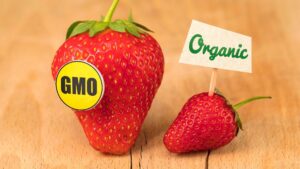 The organic food market has exploded in the last few decades. People choose organic foods for a variety of reasons, including fewer pesticides, being fresher, better tasting, and the belief that they are more nutritious than non-organic food. But what does organic really mean? Are they healthier than non-organic foods? Do they use pesticides?
The organic food market has exploded in the last few decades. People choose organic foods for a variety of reasons, including fewer pesticides, being fresher, better tasting, and the belief that they are more nutritious than non-organic food. But what does organic really mean? Are they healthier than non-organic foods? Do they use pesticides?
Definition of organic farming
US regulations specify that organic food producers cannot use growth hormones, antibiotics, synthetic pesticides, chemical fertilizers, genetically modified ingredients, or sewer sludge (1). Organic farmers can use natural fertilizers and pesticides (not synthetic). Organic farmers can use synthetic materials if they are on the National List of Allowed and Prohibited Substances (1). Synthetic material is a substance made by a chemical process that chemically alters a substance taken from a plant, animal, or mineral source (1). Instead, organic farmers use animal and crop waste, botanical, biological, or non-synthetic pest control, and synthetic materials that are allowed to break down quickly by oxygen and sunlight (1).
To convert a conventional farm to an organic farm, no prohibited substances could have been used on the farm for at least three years (1). Organic operations must be certified by a USDA-accredited inspector (1). This certification gives third-party assurance that a product was raised, processed, and distributed to meet the official organic standards (1).
Controversial organic pesticides
Rotenone
Some of the more controversial organic pesticides include rotenone, copper, nicotine sulfate, and pyrethrins. Rotenone is a naturally occurring chemical found in the seeds and stems of various plants. In organic farming, it is used as a pesticide, an insecticide, and a fish killer. Native peoples have released rotenone into ponds where it interacted with the cellular respiration of fish, causing them to go to the surface for air, where they were easily caught. Rotenone is currently being phased out for use in organic farming in the United States and Canada. It works by blocking the energy-creating pathway called the electron transport chain, which causes a backup of electrons that damage DNA.
The World Health Organization classifies rotenone as “moderately hazardous.” It is mildly toxic to humans and other mammals but extremely toxic to insects and aquatic life. Sunlight causes rotenone to break down within six days. Studies in mice have shown that rotenone doses below detectable limits have induced Parkinson’s-like symptoms in mice, and a 2011 study showed a link between rotenone use and the development of Parkinson’s disease among farm workers (2).
Pyrethrum
This is a plant compound extracted from the daisy flower after it has been ground (3). It kills insects by producing hyperactivity and convulsions. Pure pyrethrum is moderately toxic to mammals at 500 mg, but the kind used in agriculture is less toxic and requires 1500 mg to produce negative effects in rats (3). It is also broken down by the sunlight within 2 hours of application.
Neem
An insecticide from the seeds of the Indian neem tree. It causes sterility in female insects and interferes with the shell molting of insects. Neem is considered non toxic to mammals.
The Organic Symbol
The organic symbol means that a product is 100% or 95% organic. Labels “100% Organic” must use all organic ingredients. The organic symbol may also be used if a product is 95% organic, with the other 5% being from ingredients on the National List of Approved Substances. A label can say “made with organic ingredients” if the product is made up of at least 70% organic materials.
Naturally occurring toxins from selective breeding
Instead of using genetic modifications, organic farmers rely on selective breeding of plants to confer some benefit, such as chemicals found in plants that naturally deter insects. Once they isolate plants with this benefit, they breed the plants to increase the likelihood of future plants having the resistance. Sometimes this practice can result in high levels of natural toxins that are dangerous to humans.
An example of this is the tomato and potato plants, which naturally produce glycoalkloids, which are chemicals that provide insect resistance. These can be dangerous to humans at high levels, which caused the abandonment of a program to breed potatoes with high insect resistance when it was found out that they contained glycoalkloid levels that could cause acute toxicity in humans (1). This was the only example I could find, so I assume that these toxins are rarely seen.
Microbiological safety of organic vs. conventional products
Conventional, not organic
Although organic and conventional farming both rely on the use of animal manure as fertilizer, organic farmers may rely more heavily on animal manure since they cannot use synthetic fertilizers as many conventional farmers do (1). Even if true, this does not automatically mean more microbiological contamination of organic products. One of the few studies on this topic compared levels of Escherichia coli, Salmonella, and Escherichia coli 0157:H7 in organic vs. conventional foods (4).
The study found that none of the samples contained Escherichia coli 0157:H7, while only two samples (organic lettuce and organic peppers) contained Salmonella. Generic E. coli was found in 9.7% of the organic samples and 1.6% of the conventional samples. When using certified organic produce, the 9.7% was reduced to 4.3%, which was not significantly different from the rate found in conventional products. When comparing generic E. coli in lettuce, certified organic foods had a 0% infected rate, non certified organic foods had a 31% infected rate, and conventional foods had a 17% infected rate.
Nitrogen levels
The European Union specifies that organic farms must have a lower nitrogen concentration than conventional farms in order to be categorized as organic. Most studies have shown that organic foods consistently have lower levels of nitrates and nitrites than conventional foods. Nitrates can easily be converted to nitrites, which cause a dangerous illness in babies, the elderly, and infants called methemoglobinemia (5). Another issue is that nitrites are able to react with amines to create nitrosamines, which have been shown to be carcinogenic and mutagenic, causing leukemia and cancer of the digestive tract (5). On average, switching from conventional to organic foods will lead to a 50% reduction in the intake of dietary nitrates and nitrites (5).
Are organic foods healthier than conventional foods?
The research in this area has produced mixed results. Some studies found that organic foods contained more phytochemicals than conventional foods, while other studies found no difference. I personally think the biggest variables in nutrient composition are the soil type, climate, soil cultivation, fertilizer used, and how crops are stored after being picked. I am willing to bet that if similar conventional plants were analyzed from different parts of the country, they would differ in their nutritional make-up for reasons I just previously mentioned. Even if organic foods have slightly higher levels of phytochemicals, they are likely so small as to impart no extra health benefits.
Crop variety in organic farming
Organic farms and conventional farms use different farming methods. Organic farming stresses crop diversity. Benefits from planting many species of plants on the same land include supporting a wider range of beneficial insects and soil microorganisms, and it helps the soil remain viable for a longer time. Conventional farming stresses monoculture. This practice stresses only one type of crop per field, which over time depletes the soil and makes it inhabitable to grow plants.
To improve soil fertility, organic farming uses a variety of methods, including crop rotation, reduced tillage, cover cropping, and the application of compost. Organic farming stresses maintaining soil fertility for the long term, while conventional farming does not. From a sustainability standpoint, organic farming is better for the land and geared more towards making the most use of the land for the longest period of time.
| Dirty Dozen-high pesticides | Clean 15-low pesticides |
| Apples | Avocados |
| Strawberries | Sweet Corn |
| Grapes | Sweet Potatoes |
| Celery | Mango |
| Peaches | Cauliflower |
| Spinach | Cantaloupe |
| Sweet Bell Pepper | Eggplant |
| Nectarines | Kiwi |
| Cucumbers | Papaya |
| Cherry Tomatoes | Sweet Peas |
| Potatoes | Cabbage |
| Snap peas | Pineapple |
| Kale / Collards | Grape Fruit |
| Onions | |
| Asparagus |
Discussion
People choose to eat organic foods for a variety of reasons. For me, I would choose organic foods because they contain fewer pesticides. They are also better for the environment, but that does not matter as much to me. Natural does not always mean safe. Metals are perfectly natural, but if you consume too much, they can be fatal. On the other hand, synthetic or unnatural does not always mean unsafe.
Having said that, it seems evident that organic pesticides are less toxic, more degradable, and better for the environment than synthetic pesticides. If you have the money, I would make all of your food organic. If you cannot afford to buy everything organic, try to at least get the food on the dirty dozen list since it contains the highest amounts of pesticides.
I do not believe that organic foods are inherently healthier than similar conventional foods. I believe most of the health benefits from organic foods come from fewer and less toxic pesticides. One issue is that we import a ton of fruits and vegetables from other countries that may claim a product is organic, but it would be difficult for the USDA to check every import for pesticides. That is why it is better to buy from the United States, as we have more stringent testing here.
Sources
- Winter, C. K., & Davis, S. F. (2006). Organic foods. Journal of Food Science, 71(9), R117-R124.
- Tanner, C. M., Kamel, F., Ross, G., Hoppin, J. A., Goldman, S. M., Korell, M., … & Langston, J. W. (2011). Rotenone, paraquat, and Parkinson’s disease. Environmental health perspectives, 119(6), 866-872.
- Isman, M. B. (2006). Botanical insecticides, deterrents, and repellents in modern agriculture and an increasingly regulated world. Annu. Rev. Entomol., 51, 45-66.
- Mukherjee, A., Speh, D., Dyck, E., & Diez-Gonzalez, F. (2004). Preharvest evaluation of coliforms, Escherichia coli, Salmonella, and Escherichia coli O157: H7 in organic and conventional produce grown by Minnesota farmers. Journal of Food Protection®, 67(5), 894-900.
- Rembiałkowska, E. (2007). Quality of plant products from organic agriculture. Journal of the Science of Food and Agriculture, 87(15), 2757-2762.




I will try to memorize the dirty dozen list, so when I go to the supermarket I know what to buy organic.
You explain in detail but to the point what Organic means. Again, nice blog!
Hey Lucia. I tend to remember the list when I go food shopping as well. I highly recommend buying organic apples since they are so high in pesticides and are quite cheap to buy organic. Other foods can get costly if you buy them organic but if you follow the list I mentioned the trade off will be worth it.